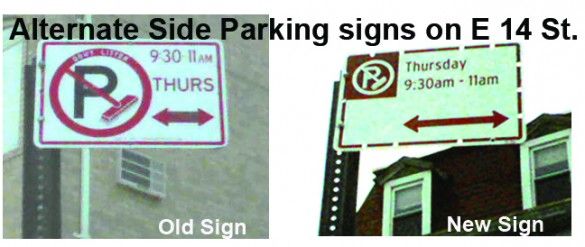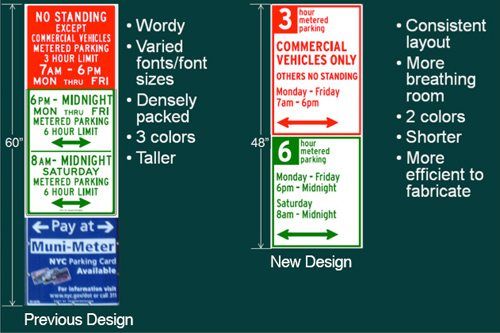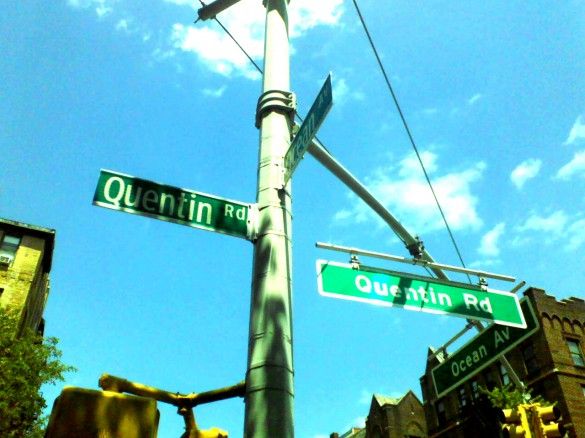New No Parking Signs Are Appearing In Sheepshead Bay, And More

THE COMMUTE: In early 2012, we reported on confusing Department of Transportation (DOT) parking and traffic regulations and on confusing and outdated signage mentioning the taxi stand on Brighton Beach Avenue. That stand is not even listed in DOT’s database of taxi stands so apparently they are unaware of its existence.
In January 2013, DOT — realizing the problems with existing signage that were causing unnecessary confusion — unveiled a new format for parking regulatory signs, which shortly thereafter began to make their appearance in Manhattan. A consultant was hired who devised what you see here.

But is it really an improvement? We criticized the omission of not showing the direction of the closest Muni-Meters here. The new format looks cleaner and helps when many signs are placed together, but when you just consider just two simple “No Parking” signs, I find the old ones clearer and more functional.
Compare the two signs on East 14th Street, south of Avenue Z, pictured above. De-emphasizing the “No Parking” graphic was a good idea. But was it really necessary to spell out the days of the week? Don’t most people recognize “THURS” as “Thursday”? Isn’t saying “9 – 11:30 AM” clear enough? Is “9:30am – 11am” in lowercase without punctuation any clearer or is it even more confusing? Does it make sense to use a smaller typeface and a condensed font as well? I don’t think so.
The old sign is visible from a distance of 50 feet. The new one requires you to walk right up to the sign to within about five feet to be able to read the smaller, lowercase, condensed font. That means every time you park your car you must walk an additional 90 feet to and from the “No Parking” sign. While you used to just be able to throw your coins into the parking meters where you park, you now have to walk 200 feet or more to and from the Muni-Meters, all part of Mayor Bloomberg’s health policies to give us all more exercise. Of course the mayor won’t get the extra exercise since he can park wherever he wants.
The new signs will replace the old ones as they wear out or fall off.
New Street Signs
Several years ago, DOT started placing supersized street signs along major arterials such as Ocean Parkway. Then they continued placing more of them along avenues such as Coney Island Avenue and Ocean Avenue. These make driving easier, especially at night since they are far more visible than the standard signs. Cities that are more auto-oriented than ours had these signs many years before they were unveiled in New York. My guess is that these are federally funded and DOT installed them because the money was available, so why not take advantage of it? That is the way a city bureaucracy thinks.
Now a few years later an announcement was made that all street signs would be replaced with new signage because of federally-mandated lowercase lettering for standard signs since studies showed they were easier to read. Seen as a colossal waste of money by elected officials and the public, the city soon relented, stating that the new signs would be phased in only as old ones fall down or become too faded to read; they would not replace perfectly good signage. (Of course we never had a problem with fading when the signs were made of metal instead of vinyl.) That decision seemed to make everyone happy.
The Twain Shall Meet
What happens when an old standard sign needs to be replaced, but a newer, supersized sign was already placed at the same intersection? I thought that when that would happen, the old sign would just not be replaced because there would be no need for it. It made no sense to assign extra labor to remove the old standard sized signage. So it shouldn’t make sense to assign extra labor to replace these signs either, not to mention the cost of the signs. Hey, but the cost does not matter when it is federal money and not “ours,” as the city bureaucracy thinks. So the result is what you see here:

Just another example of scarce resources wasted, while other problems that need to be addressed are ignored.
Also In The News
One of those problems ignored for decades will finally be fixed. I have often criticized DOT for ignoring traffic bottlenecks and intentionally creating them. Some even thought that it was Mayor Bloomberg’s way of creating traffic congestion as punishment for not supporting his congestion pricing policy a few years ago. Removing traffic bottlenecks are a simple, cost-effective means of reducing traffic congestion, which used to be DOT’s primary goal back in the 1960s.
If you are familiar with the ramps leading to the Brooklyn Bridge from the FDR, you will be interested in this. There used to be merge into a single lane upon entering the Brooklyn Bridge southbound. That was converted into a double lane many years ago, with a minimal amount of construction saving cars at least five minutes. However, the same problem that has existed for decades upon leaving the FDR, where only the right lane can enter the bridge ramp or exit at Pearl Street, created massive traffic jams lasting at least 15 minutes. Savvy motorists would save themselves time by sneaking in at the last possible moment until DOT decided to erect bollards, which only made the congestion worse.
So after 20 years, DOT has finally come to its senses and has decided to allow two lanes to exit the FDR for the Brooklyn Bridge, where about 90 percent of the traffic is destined, instead of forcing cars to unnecessarily merge into a single lane only to separate back into two lanes after the merge. The change will be made in 2014.
Non-drivers who believe that automobiles are the greatest evil in the city will undoubtedly criticize DOT for finally realizing that congestion benefits no one, claiming this single change will cause everyone to purchase an automobile and traffic will soon revert to its former level of congestion. Nothing could be further from the truth. Many factors are considered in the decision to purchase an automobile and one small change such as this one has no effect. As proof, I recall the constant bumper-to-bumper congestion on the BQE southbound (parallel to Hicks Street) that existed in the 1970s everyday from 6:00 a.m. to 10:00 p.m. That was alleviated with the addition of a new ramp eliminating a bottleneck merge, which reduced that bumper-to bumper-traffic from 16 to about three hours a day and it remained that way. A speed of 20 to 40 miles per hour is now the norm.
Conclusion
The biggest crime here is that all it will take to add that extra lane exiting the FDR to enter the Brooklyn Bridge is just some re-striping and the removal of bollards, which never should have been placed there in the first place. No new construction is even necessary. Yet we still will have to wait another year while countless drivers continue to suffer unnecessarily as they have done for decades and decades because of sheer stupidity.
Now if only DOT would use some common sense by not repeating the mistake they made at Quentin Road and Ocean Avenue, of installing unnecessary new standard street signage at a corner where the super-sized signs already exist. Instead, they should use a larger, non-condensed font on the new “No Parking” signs to make them visible from a greater distance.
But that would just be asking for too much.
The Commute is a weekly feature highlighting news and information about the city’s mass transit system and transportation infrastructure. It is written by Allan Rosen, a Manhattan Beach resident and former Director of MTA / NYC Transit Bus Planning (1981).
Disclaimer: The above is an opinion column and may not represent the thoughts or position of Sheepshead Bites. Based upon their expertise in their respective fields, our columnists are responsible for fact-checking their own work, and their submissions are edited only for length, grammar and clarity. If you would like to submit an opinion piece or become a regularly featured contributor, please e-mail nberke [at] sheepsheadbites [dot] com.




